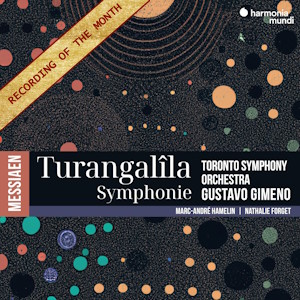
Olivier Messiaen (1908-1992)
Turangalîla-Symphonie (1946-1948, rev. 1990)
Marc-André Hamelin (piano)
Nathalie Forget (ondes Martenot)
Toronto Symphony Orchestra/Gustavo Gimeno
rec. 2023, Roy Thomson Hall, Toronto, Canada
Reviewed as a 24/192 download
Harmonia Mundi HMM905336 [73]
Seventy-six years on, the Turangalîla-Symphonie still feels remarkably modern. Indeed, its soundscapes foreshadow those of Messiaen’s other large-scale works, La Transfiguration de Notre Seigneur Jésus-Christ (1969), Des canyons aux étoiles… (1976) and Éclairs sur l’Au-Delà… (1991). The symphony, scored for a substantial orchestra, solo piano and ondes Martenot, has fared quite well on record (more on that later.) It’s played here by the Toronto SO, conducted by their new music director, the Valencia-born Gustavo Gimeno. He is also chief conductor of the Orchestre Philharmonique du Luxembourg with whom he has recorded several albums for Pentatone. And while I had some reservations about one of these – an all-Shostakovich programme (review) – I do feel the Spaniard, still in his forties, is a baton-waver to watch.
Collectors in search of a decent Turangalîla have quite a few to choose from, some with A-list interpreters and ensembles. Forced to pick my top five, I’d nominate, in chronological order: the classic André Previn LSO performance, recorded at Abbey Road in 1977 (EMI-Warner); Riccardo Chailly and the Concertgebouw (Decca, 1992); Kent Nagano and the Berliner Philharmoniker (Teldec, 2000); Juanjo Mena and the Bergen Phil (review); and last but not least, a surprisingly effective live recording from 2019, with Alexander Soddy and the Nationaltheater-Orchester Mannheim (review). Curious listeners who want to hear Turangalîla in the context of Messiaen’s other orchestral works should investigate the box from Sylvain Cambreling and the SWR Sinfonieorchester Baden-Baden und Freiburg (review), or the Deutsche Grammophon set, split between Myung-whun Chung in Paris and Pierre Boulez in Cleveland.
First impressions of Gimeno’s Turangalîla are entirely positive; ensemble is crisp, rhythms are well articulated and there’s a strong, clear pulse throughout. In short, all prerequisites for a memorable performance of this extraordinary score. And then there are the soloists, pianist Marc-André Hamelin and Nathalie Forget on the ondes, both ideally integrated into a broad, deep soundstage. Indeed, the recording team have created a well-nigh perfect environment in which this music thrives. Messiaen’s trademark tuttis expand in the most natural way, and the strings – the lower ones in particular – emerge with commendable clarity, all a welcome reminder of the work’s many layers and contrasts. As for the all-important percussion instruments, they’re superbly arrayed and rendered, the soft bass-drum thuds in Chant d’amour 1 adding real frisson to the proceedings.
The Toronto Symphony’s first recording, made with Seiji Ozawa in 1967, is comparatively disappointing; apart from the fact that it uses the composer’s original score, the sound strikes me as oddly synthetic. The soloists, Yvonne and Jeanne Loriod on piano and ondes respectively, are too far forward for my taste, the former overbright, too. Overall, the effect is somewhat fatiguing. I dare say Ozawa’s performance was welcomed on its first release, but nearly sixty years on it just doesn’t make the grade. Indeed, as much as it pains me to say so, even the Previn version, my unforgettable introduction to the piece, is now starting to look dispensable. For a more enthusiastic response of the first Toronto recording, see here.
Gimeno and his team really shine in the two central movements, Joie du sang des étoilesand Jardin du sommeil d’amour, the first imbued with a rare luminosity, the restrained tuttis more radiant than I’ve ever heard them. The gentle percussive plosions here are no less ear-tweaking, the heady languor of that enchanted garden beautifully caught. As always, the soloists remain entirely musical, forming as they do integral parts of the symphonic fabric. Goodness, I can’t recall a more evanescent performance of this ravishing music, either on record or in the concert hall. Even the more trenchant passages of the three Turangalîla sections are perfectly controlled, the orchestra playing with a real sense of commitment and style. The Finale is no less impressive. I would not wish to be without the Nagano or Mena versions, but I suspect it is this new Toronto recording that I’ll return to most often. Indeed, if proof were needed that the Turangalîla-Symphonie is a masterpiece, here it is.
A top-notch Turangalîla from Toronto; stellar sonics, too.
Dan Morgan
Help us financially by purchasing from



















